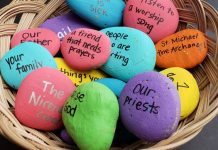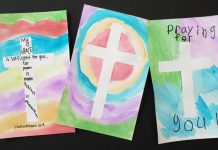
KATE RISTOW
Waiting, especially at this time of the year, is a concept children understand. From our youngest students to even the most blasé junior high youngster, almost everyone counts the days until Christmas. In the same way, all of our students are hoping. More often than not, their hopes are materialistic and usually all wrapped up in what they want for Christmas: the newest iPhone, a fully accessorized American Girl doll, dinosaur action figures, and the like. The challenge for us as catechists is to build on the kids’ commercialized versions of waiting and hoping and help them to see that as children of God and members of the Church, we too wait and hope—for deeper reasons—at this time of the year.
A New Church Year
Advent marks the beginning of the liturgical year. Each week during this, Year C in the three-year cycle of Sunday readings, Luke’s Gospel will be proclaimed. Luke calls us to hope in God’s promise of eternal life made possible by the birth, life, death, resurrection, and ascension of Jesus Christ. In Luke’s Gospel, we meet people who invite us to a new way of living that is only possible because God sent his only son to live among us and announce that the kingdom of God was at hand. For example, on the Second Sunday of Advent we meet John the Baptist, and two weeks later we hear the story of John’s mother, Elizabeth, greeting Mary—the first human to acknowledge her as the mother of the Lord.
Explore with your class why these stories give us hope. Help the students appreciate that the Jewish people waited for generations for God to send the promised Savior. Explore other stories that underscore the hope God’s people kept in his promise. Introduce the children to Zechariah, Elizabeth’s husband and the father of John the Baptist (Luke 1:5-25, 57-80); it is not told in the Sunday Advent readings, but it is a wonderful story to share with the class. In this age of in vitro fertilization and surrogate pregnancy, it is a joy to share the miracle of a married couple well past their prime giving birth to a longed-for child.
Ask your music minister for a musical version of Zechariah’s canticle that you can share with your class. I like “Now Bless the God of Israel” by Ruth Duck. In the second verse we sing, “Remembering the covenant, God rescues us from fear, that we might serve in holiness and peace from year to year.” Ask older students to work in small groups to create a list of ways they can serve in holiness and peace in preparation for Christmas.
Focus on Hope
Through technology and television, our students are exposed to a constant barrage of tragedy around the world. Help them prepare for Christmas by reflecting on how our faith in Jesus gives us hope. Work with younger students to write a short prayer expressing their hopes in and for Jesus. Pray it together to conclude each of your Advent sessions.
Invite older kids to work in pairs to write petitions expressing the need for the hope Jesus brings to our world. For example: “For those who are treated unjustly… .” When they finish writing their petitions, have volunteers suggest a communal response they can pray, such as: “Bring hope and healing into our lives, Jesus.”
You might also have older students each write a five-sentence paragraph explaining why Jesus gives them hope. After sharing their work with the class, encourage students to copy their paragraphs neatly onto lined paper and display them in a public area of the parish. Place a placard near the display inviting parishioners to spend some time during Advent reflecting on why Jesus gives them hope.
Making Connections
Recall that a special 12-month Church holy year convened by Pope Francis begins during Advent on December 8, the Solemnity of the Immaculate Conception. Emphasize that during Advent we can open our hearts to God’s merciful love and we can share God’s mercy with others through our daily words and actions.
Work with the children to create an examination of conscience based on the Ten Commandments with hope in God’s mercy as the focus. For example: “How can I grow closer to God by putting him first in my life?” or “What are some ways I can show greater love for my parents?”
Make the completed examination the centerpiece of an Advent communal reconciliation service. Use 1John 3:1 as your reading to reinforce that our greatest hope stems from our belief that through baptism we become members of the Body of Christ, the Church. Have a volunteer read aloud the examination of conscience and allow time for the students to reflect in silence. Continue by inviting them to sign themselves with water from the baptismal font. Conclude by praying together the Act of Hope.
If possible, make copies of the examination to distribute to the children for use at home. Encourage the students to use the examination to think about what they can do on a daily basis to welcome Jesus into their hearts at Christmas.
Caring for the Earth During Advent
In preparation for Christmas, kids love to make decorations for home or gifts for the special people in their lives. This year, consider activities designed in the spirit of Pope Francis’ encyclical regarding the environment, Laudato Si’ (On Care for Our Common Home). In his letter, the pope wrote: “All of us can cooperate as instruments of God for the care of creation” (14). Talk briefly with the students about the pope reminding us that our planet is a gift from God that we are called to care for. Emphasize that recycling or repurposing materials is one way each of us can be an instrument of care for creation as the pope asks. Here are two ideas to implement in your classroom.
Good Deed Garlands
Invite the children to make colorful construction-paper garlands that will serve both as an incentive and record of “keeping” Advent. Give each student six 10” x 1” strips of construction paper in a variety of colors. Invite them to write on the first strip one thing they will do to prepare to welcome Jesus to their hearts on Christmas (be kinder to my older sister, set the table without being asked, and so forth). Then have them write another Advent resolution on the second strip. Show them how to use a glue stick to loop and link the two strips into a small chain.
Encourage them to remember to keep these two Advent promises and to add to the chain each day by using the extra slips to make a link for every good deed they perform, every special prayer they say, or anytime they help another person. Point out that the chains are tangible signs of their preparation for Christmas. Encourage them to string the garlands on their Christmas trees at home. Point out that after Christmas they can recycle their chains, showing care for our environment as good stewards of the earth.
Keep in mind that this activity is not just for primary students. Even junior high kids need to mark their progress in growing as disciples of Jesus.
Christmas Photo Ornament
Every family has a stack of CDs that are no longer in use. Work with the children to turn one of those unused CDs into a photo ornament. Each student will need to bring to class a CD and a “selfie,” a family photo, or some other photo subject the gift recipient will enjoy. You will need to supply felt, craft glue, fabric markers, thin ribbon, and scissors. Before class, trace around the CD on the felt and cut out two felt circles for each student. Older students can do this independently with your supervision.
Have each student make a small loop from an 8”-10” length of ribbon and glue the two ends together. Then demonstrate how to glue the loop to the top of the back of the CD so it becomes a hanger. Instruct them to then use glue to cover the back with one of the felt circles.
Show them how to lay out their photo and glue it to the middle of the second piece of felt. Then have them glue the felt to the front of their CD. The kids can even write a brief message on the CD using fabric markers. The ornaments can hang on the tree during the Christmas season and later be used to decorate a workspace or shelf.
Kate Ristow has worked in Catholic publishing for more than 30 years as a national speaker and writer, building on a wealth of experience in the religious formation of children and catechists in both parish and Catholic school programs.
This article first appeared in Catechist magazine, March 2015.
Image Credit: Gareth Harper, Unsplash




